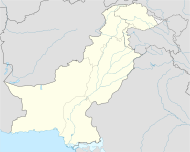Shrine of Shah Abdul Latif Bhittai
| Shrine of Shah Abdul Latif Bhittai | |
|---|---|
 The shrine complex of Shah Abdul Latif Bhittai | |
| Religion | |
| Affiliation | Sufi |
| District | Matiari |
| Province | Sindh |
| Location | |
| Location | Bhit Shah |
| Country | Pakistan |
| Geographic coordinates | 25°48′22″N 68°29′29″E / 25.806005°N 68.4915225°E |
| Architecture | |
| Type | Mosque and Sufi mausoleum |
| Style | Indo-Islamic |
| Completed | 1772 C.E. |
The Shrine of Shah Abdul Latif Bhittai (Urdu: شاہ عبداللطیف بھٹائی مزار; Sindhi: شاهہ عبداللطيف ڀٽائي جي مزار) is an 18th-century Sufi shrine located in the town of Bhit Shah, in the Pakistani province of Sindh. The shrine is considered to be one of the most important in Sindh, and its annual urs festival attracts up to 500,000 visitors.[1]
Background
The shrine was built for Shah Abdul Latif Bhittai, a noted Sindhi Sufi scholar, mystic, saint, and poet who is widely considered to be the greatest Muslim poet of the Sindhi language.[2] His collected poems were assembled in the compilation Shah Jo Risalo. The shrine is 125 kilometres from the popular Shrine of Lal Shahbaz Qalandar in Sehwan Sharif.[3] Former Secretary of State Hillary Clinton visited the shrine in 2009.[4]
Building complex
The shrine complex was built in 1772 by Mian Ghulam Shah Kalhoro to house the tomb of the Shah Abdul Latif Bhittai.[5] The shrine complex includes a mosque and a mausoleum that open onto a large courtyard encircled by domed arcades by means of a large gateway. The complex is notable for being elaborately decorated with Sindhi tile work featuring blue and white floral themes.[6]
Annual festival
The shrine is site of an annual urs festival that attracts up to 500,000 visitors over the course of three days,[7] beginning on the 13th day of the Islamic month of Safar.[8] The festival commemorates Shah Abdul Latif's death by means of celebration, as his death is regarded to be a union with God.[9]
See also
Gallery
-
The shrine is elaborately embellished with Sindhi-style tilework
-
Entry to the inner sanctum
-
Former US Secretary of State Hillary Clinton visited the shrine in 2009.
-
The shrine's inner sanctum is the site of the saint's tomb.
-
The shrine's gateway connects the shrine complex to its courtyard.
-
The shrine attracts Sufi musicians who recite Bhittai's poetry.
References
- ^ Khan, Mohammad Hussain. "Shah Abdul Latif Bhitai's 272nd urs kicks off in Bhit Shah". Dawn. Retrieved 4 March 2017.
The shrine witnesses a turnout of close to 500,000 devotees including foreigners during the three days.
- ^ "saintsofislam". saintsofislam.com. Retrieved 4 March 2017.
- ^ "Map of the distance between Sehwan Sharif and Bhit Shah". Open Street. OSM. Retrieved 4 March 2017.
- ^ https://www.flickr.com/photos/statephotos/4057740172/ Secretary Clinton Visits Shrine of Shah Abdul Latif Kazmi
- ^ Ahmed, Vaqar (10 April 2015). "Bhit Shah: After the dhamaal". Dawn. Retrieved 4 March 2017.
- ^ Said, Farida (27 March 2015). "Tradition of the tile". Dawn. Herald Magazine. Retrieved 4 March 2017.
- ^ Khan, Mohammad Hussain. "Shah Abdul Latif Bhitai's 272nd urs kicks off in Bhit Shah". Dawn. Retrieved 4 March 2017.
The shrine witnesses a turnout of close to 500,000 devotees including foreigners during the three days.
- ^ "Spiritual colours of Shah Abdul Latif Bhitai". Dawn. 15 November 2016. Retrieved 4 March 2017.
- ^ "Shah Abdul Latif Bhitai's 272nd urs kicks off in Bhit Shah". Dawn. 27 November 2015. Retrieved 4 March 2017.








